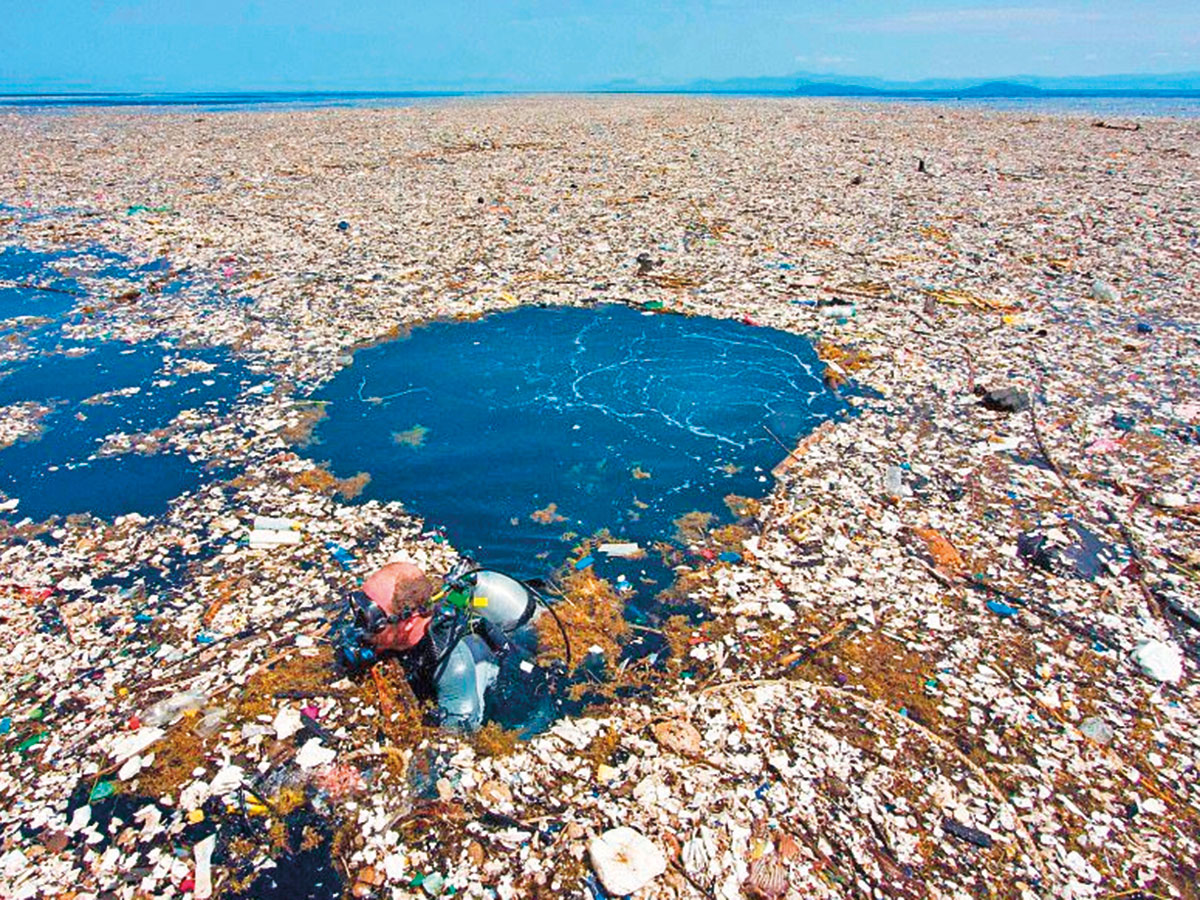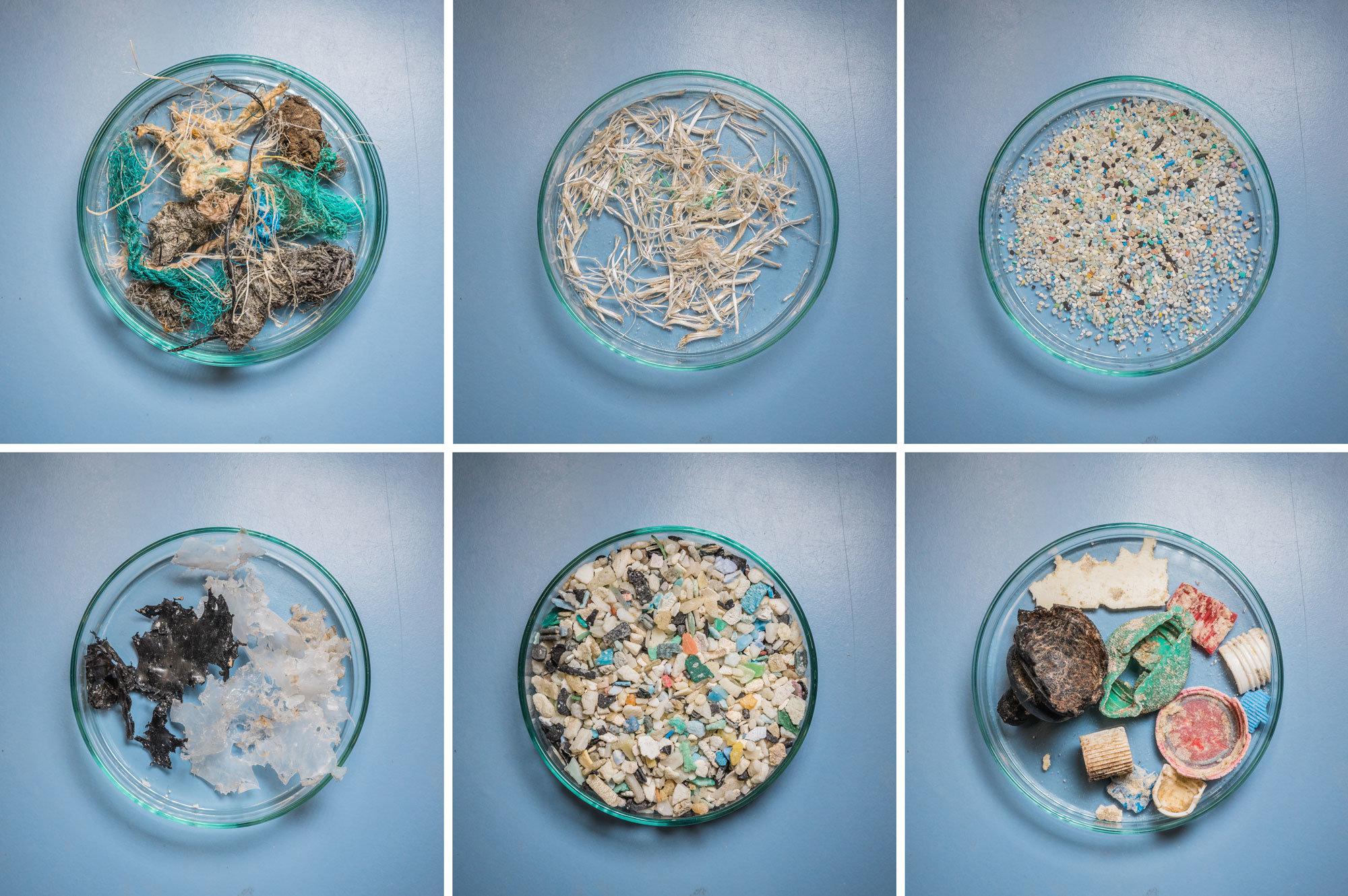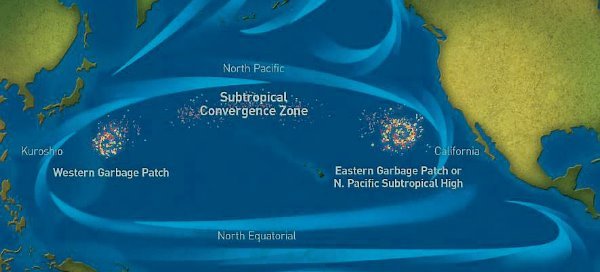Floating Trash: more than 4x as bad as we thought
Key concepts:
• scale of the plastic trash problem
• lack of accurate data
• rate of growth of plastic trash
• actions that have raised global awareness
March 22, 2018 NPR reported that the so-called “Great Pacific Garbage Patch,” typically reported as “the size of Texas” has been reported as 4 to 16 times larger than past estimates, according to a paper published that day in Nature Scientific Reports by Laurent Lebreton, an oceanographer with The Ocean Cleanup Foundation. Not only was the trash patch larger, this massive pile of swirling trash, located between California and Hawaii, was found to have had the highest concentration of plastic ever recorded in one area.

A more accurate estimate was possible because the team took more than 7,000 aerial photographs of the area, rather than simply observing from boats. The patch is formed because Earth’s rotation causes water to circulate around the equator, powering clockwise currents in this area.
The New York Times wrote on March 22, 2018 that the patch is growing exponentially, so even this revised estimate will be wrong soon, that the area is roughly four times the size of California and composed of an estimated 1.8 trillion pieces of rubbish and weighing 87,000 tons. Some sea turtles caught near the patch had eaten so much plastic that it made up around three-quarters of their diet, according to the Ocean Cleanup Foundation.

As part of the study, researchers sorted plastic by size to begin to understand how the material breaks down at sea. Credit: Ocean Cleanup Foundation. The microplastic problem is pervasive.
NBC also covered this news: “The vast dump of plastic waste swirling in the Pacific ocean is now bigger than France, Germany and Spain combined — far larger than previously feared — and is growing rapidly, quoting a study published on March 22, 2018. The widespread global news coverage means that at least the world is listening. But what are we doing? The Netherlands-based Ocean Cleanup Foundation cannot tackle this alone. And after-the-fact cleanup is not a long-term solution. Plastic that ends up in oceans needs to be stopped at its source.

Sir David Attenborough in his recent BBC One documentary series Blue Planet II, brought the plight of marine life blighted by tonnes of discarded plastic containers to the world’s attention. One shift: around 5.5 billion liters of milk is sold in the UK each year, according to the industry body Dairy UK. Though only three per cent of this is delivered to the doorstep today, there’s a new surge in inquiries for milk delivered in glass bottles because people don’t want to drink from plastic.
The Manila Times describes our global plastic challenge as “the plastic Armageddon.” The Philippines is unfairly described as the third largest plastic polluter, since the Philippines is not even on the list of the largest plastic producers.
The Swiss Ship Fleur de Passion was sent out in 2015 on a four year expedition to survey the state of our oceans. This ‘Ocean Mapping Expedition’ is finding seas full of plastic and stinking waste. Swiss public television, SRF, recently documented the crew at their news conference in Singapore.
The National Oceanic and Atmospheric Administration has found that ghost gear (nets and other fishing gear no longer in use and left in the ocean) can have serious impacts on a range of marine animals,” wrote Nancy Wallace, Director of the NOAA’s Marine Debris Program. “We need to focus on generating less waste and stopping the flow of debris into our waterways and ocean. This will take significant effort, but awareness around this issue is growing and people are willing to make changes to make an impact.” Reuters has also done a media story on this crisis. President Trump’s new budget will cut NOAA’s budget by more than a billion dollars. More>
The Ocean Conservancy’s Trash Free Seas Alliance®, founded in 2012, unites industry, science and conservation leaders who share a common goal for a healthy ocean free of trash. The Alliance provides a constructive forum focused on identifying opportunities for cross-sector solutions that drive action and foster innovation. The Alliance has an array of large industry members, including
- The Coca-Cola Company
- Covanta Energy
- The Dow Chemical Company
- ITW
- Amcor
- American Chemistry Council
- Bank of America
- Cox Enterprises
- DANONE
- Dart Container Corporation
- Nestlé Waters NA
- Procter & Gamble
- REDISA
- Walmart
- The World Plastics Council
The program also includes many high profile non-profit environmental organizations, such as the World Wildlife Fund and World Animal Protection, enabling these leaders to mix with industry leaders.
Nick Mallos, Director of the Program, says that there are many ways for trash to disappear from view for awhile, whether by sinking into sediment, or being ingested by marine organisms, or being spit out onto beaches. He argues that the most cost-effective remedy is to “cut off the source.”
Other companies innovating to address the plastic challenge include:
- Adidas – launching a new collection of shoes fabricated from recycled plastic.
- Sky Media – the world’s first carbon neutral media company, having previously raised £9m to protect the Amazon rainforest, and Sky is the first FTSE 100 company to commit to being single-use-plastic-free by 2020.
See next month’s article on corporate leadership.
Reverse Vending Machines
The idea of reverse vending machines to receive recycled plastic bottles is gaining momentum.
Britain uses around 13 billion plastic drinks bottles a year, with 7.5 billion ending up in landfill, being incinerated, or in the oceans.
Deposit return schemes have already seen great success across the rest of the world. Shoppers in Sweden pay a deposit of 8p, while in Germany it’s 22p — which has led to a 97% recycling rate.
France became the first nation to ban plastic plates and cutlery in a law that will take effect in 2020.
A network of “reverse vending machines” allows shoppers to put their bottles or cans into the machine to get their deposit back.
From Plastic Storms to Plastic Vacations
Severe storms attributed to climate change and the pursuit of unsafe energy production are connected to the plastic problem. The tsunami in Japan following the 2011 Fukushima nuclear disaster sent millions of tons of debris into the ocean.
LA Times Reporter Mariel Garza suggests that The plastic junkyard in the middle of the Pacific Ocean sounds like a perfect vacation spot for lawmakers. Organizations hoping to get favorable treatment for certain industries, or support for particular policies, frequently underwrite junkets to exotic locales. Why not fund one to educate legislators about where all those grocery bags, polystyrene takeout containers, straws and utensils they aren’t banning end up? If there’s a funder, she’s offered to put together a junket for state legislators. Surprisingly, California is the only state that has banned plastic bags.
Foresight Future of the Sea Report forecasts that the amount of plastic in the world’s oceans could be set to triple over the next decade unless litter is curbed. The Report, published by the UK’s Government Office for Science, identifies four major areas that can deliver opportunities for the UK by exploiting its science and innovation – an improved understanding of the sea, greater co-ordination, a long-term approach to decision making and the increasing global nature of the challenges we face.
See the app @ earthDECKS.org
Saving Our Oceans from Plastic: articles by Zann Gill
- Adverse Health Effects of Plastic
- Aquaria – Informal Learning Network
- Beat the Microbead
- Bibliography: Plastic Roads
- Boyan Slat: Floater Technology for Ocean Cleanup
- Complex Systems Problems
- Cradle to Grave: Plastic Supply Chain
- Dame Ellen MacArthur: The Circular Economy
- Sylvia Earle: Learning for a Plastic World
- earthDECKS Limelights: Companies to Watch
- Enshrouded in Plastic
- Flamingos Signal the Future We Face
- Give the World a Helping Hand: 3D Prostheses
- Global Ocean Sensing
- Industry Response to the Plastic Challenge
- Nature’s Innovators: plastic consumers
- Ocean Debris Network
- Ocean Ingenuity
- Oceans – Measuring Planet Health
- Plastic Bank – The Exchange Economy
- Plastic – Climate Change Connection: Israel & UBQ
- PLASTIC: Complex Systems Problem
- Plastic: Drinking Water, Table Salt & Mother’s Milk
- Plastic Footprint – Carbon Footprint
- Plastic-Eating Enzyme
- Plastic Gyres and Social Justice
- Plastic Impact Calculator
- Plastic Pollution Coalition: Campaign vs Single Use Plastic
- Plastic & Public Health: Endocrine Disruptors
- PLASTIC: Overview of National Leadership
- Plastic Roads – Global Innovation Ecosystem
- Plastic – The Circular Economy
- The Plasticene
- Plastiki: adventure stories & a big message
- Raising Awareness of Plastic Hazards
